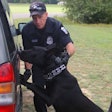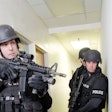As trainers, one of our main jobs is to take what the boss gives us, and operationalize it for the troops. That often means just passing things on, but sometimes we also have to translate. Part of the process is to develop lesson plans, and then presentations, that impart the information to our students.
As a "profession," law enforcement is growing a body of knowledge, especially as it relates to high-risk activities, such as use of force, driving, and arrest practices. That body of knowledge relies upon certain terminology to illustrate concepts and ideas in an easily understood context. When we choose terminology to illustrate ideas, the temptation is always there to "make it sound good." That's usually OK, but sometimes the effort to make it sound good can create problems for us.
One of the best examples of this is use of the term "lethal force." Traditionally, we have referred to the highest level of force as "deadly force." Asked about a definition for deadly force, many trainers would default to something like, "…any force that is likely to result in death or serious injury." This definition is drawn from the Model Penal Code, and is the definition that is relied upon by the United States Supreme Court, and all the Federal Circuit Courts.
However, some trainers and administrators have begun to use the term "lethal force" when they actually mean deadly force. This is an inappropriate use of terminology. There is no "lethal force standard," but there is a deadly force standard – the courts have outlined it in Tennessee v. Garner, as well as other cases.
If you think about it, lethal force can be defined as force that is fatal. Deadly force, on the other hand, is force that is likely to be fatal, or is likely to lead to serious injury. Big difference between the two!
Another problematic area is the plethora of terms that refer to non-lethal force. For some reason, we in law enforcement have felt the need to create a rash of different terms to refer to use of force that is not deadly. In doing so we have created numerous problems for ourselves.
Force is either deadly or it's not. If it is, then the aforementioned definition of deadly force applies. If it's not, then it's simply non-deadly. We have traditionally used the term non-lethal to describe this type of force, and although that term itself is a little problematic, it's generally accepted.
Now we have "less-than-lethal" and "less-lethal."
Frankly, less-than-lethal is a synonym for non-lethal, and actually describes it better. From my perspective, less-than-lethal comes closer to what we're talking about, but we really should stay consistent, and use the term "non-deadly" force.
The term less-lethal was coined in an attempt to describe non-lethal implements like beanbag rounds, etc. There was a perception that, since these things sometimes caused deaths, they weren't really "non-lethal," so we needed another term to describe them. This was and is misguided, and here's why.
Again, either something meets the definition of deadly force or it doesn't, and the operative word is "likely." If the use of a particular tool, weapon, or technique is likely to result in death or serious injury, then it's a deadly force option. If it's unlikely, then it's non-deadly (oops, non-lethal).
This analysis is based upon the construct of proper use. Sticking with our beanbag example for a minute: Properly used, according to training, a beanbag round is not likely to result in death or serious injury. It is therefore a non-lethal weapon. Just because there is a possibility that something might be fatal does not mean that it's likely to be so.
If we were to base our evaluation of weapons and techniques on what might happen, rather than what is likely to happen, then two things would occur. First, every weapon and technique in the police arsenal would have to be classified as a deadly force option. And secondly, the standard for use of force would become a subjective one, based upon possible outcomes – instead of an objective one, based upon an officer's assessment of the reasonableness of a particular weapon, considering the likely outcome of its use.
Neither of those two things is good.

















